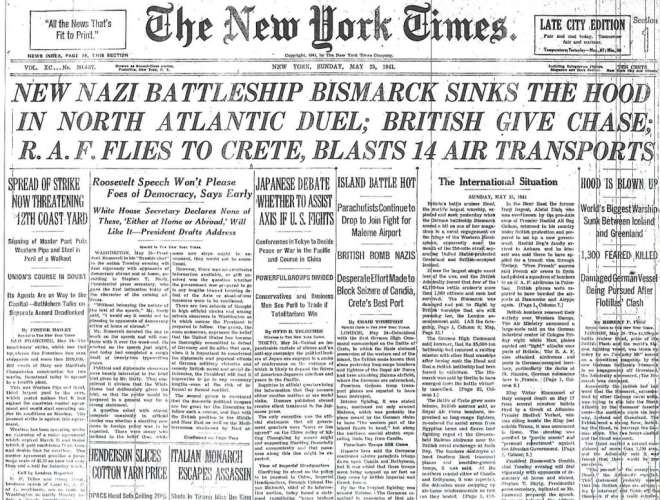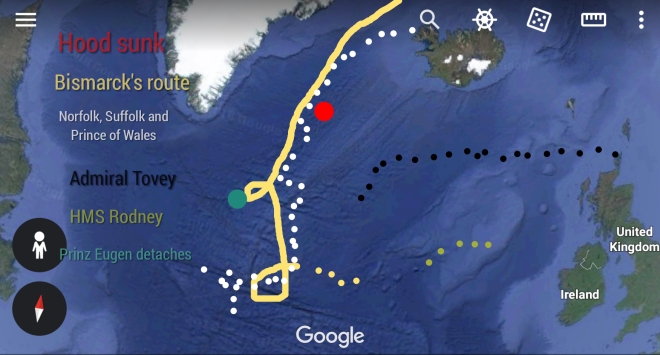This is the third part of a four part series on the battleship Bismarck.
The next day’s newspapers around the world carried but one news:

The short but shattering battle with the Royal Navy in the Denmark strait had left the German sailors in awe of their ship and of naval combat in general. Admiral Lutjens, though calm on the surface, was alarmed. He knew of the Hood’s fame, and was under no illusions about what the British would do next. The reassuring news was that while the Bismarck had lost a bit of speed, it was still cruising at at least 28 knots, which was on par with the fastest British battleships. As long as Lutjens could maintain distance, he was not under immediate threat.
The bigger problem concerned the radar: early on, during the engagement with HMS Suffolk, the Bismarck‘s guns had roared to life for the first time in battle. The force of the guns had knocked out the radar for good, which was the reason that the Prinz Eugen was leading the convoy when the Hood found her. Though the Prinz Eugen had not suffered any significant damage whatsoever, the British radars were far superior to the Germans. This meant that the two cruisers, now accompanied by the damaged Prince of Wales, could still shadow the Bismarck at a healthy range.
Another problem was the oil leak: the rupture in the fo’c’s’le tank was serious, as salt water contaminated the fuel. Lutjens must have rued his decision to not bunker fuel at Bergen. The oil trail that Bismarck was leaking was also, by no means, insignificant. Based on the situation, Lutjens could attempt to go back the way he came, pushing through the small cruisers trailing him, or attempt to make landfall in Brest (occupied France). The second option must have seemed more lucrative to Lutjens, since he had commanded the Gneisenau, along with the Scharnhorst earlier on the same route, after a moderately successful raiding operation. Additionally, the possibility of the British being able to find two lone German ships in the vast swathe of the open Atlantic seemed remote. But for that, Lutjens would have to shake off his immediate pursuers.
Admiral Tovey, meanwhile, had been personally ordered by Churchill to use every available ship to search and destroy the Bismarck. He started from Scapa Flow, onboard the King George V, the HMS Repulse, as well as the aircraft carrier HMS Victorious. Additionally, other ships such as HMS Rodney (mid Atlantic) and Force H at Gibraltar were put on alert. However, Tovey did not have the exact location of the Bismarck. Messages from the Norfolk and the Suffolk were few and far in between, and Bismarck was frequently out of their range. Tovey had to also close the distance between himself and Lutjens, but with the Bismarck cantering at a healthy speed, it seemed unlikely at the moment.
With the weather worsening, Lutjens had a much needed stroke of luck: he wanted to detach the Prinz Eugen so that she could prey on the convoys by herself while Bismarck drew attention. Soon, amidst a rain squall, Lutjens made a sharp turn to starboard and attacked his British pursuers. One sailor onboard the HMS Norfolk recalled-
” We caught the Bismarck’s turn, but couldn’t see her amidst the darkness. And then she suddenly appeared, less than 9 miles to our starboard, steaming straight at us, bow on. Panic would have struck the hearts of the bravest, and orders were given for a sharp turn to port.”
The ensuing fracas of the British realignment gave the German cruiser the chance to slip away to the southwest , unnoticed. She was to rendezvous with a German tanker and refuel, subsequently embarking on the remnants of the Operation Rheinübung alone. The Bismarck resumed her original course, and eventually turned southeast, but her British pursuers had become wary. The cruel irony was that the code word for this entire exercise between the Bismarck and Prinz Eugen was “Hood“.

(Auf Wiedersehen, Prinz Eugen!)
But the turn southeast also meant that the Bismarck was now closer to Tovey’s fleet. Based on the report of the Norfolk, HMS Victorious launched swordfish fighters which barely had the range the reach the German ship. Yet, due to inexperience and less than optimal weather conditions, the swordfish fighters almost attacked the HMS Norfolk, giving the German anti-aircraft time to assume action stations. However, something surprising happened: Bismarck‘s state-of-the-art gunnery could not shoot one swordfish out of the sky. Meanwhile, the swordfish were able to launch multiple torpedoes at the venerable ship. But to say that the swordfish had the last laugh would be an overstatement. Only one torpedo hit the main armor belt, causing no significant damage. The Bismarck cruised on.
Yet, Lutjens was already planning his next move: he knew that being in the reach of an aircraft carrier meant that his idea of disappearing in the Atlantic was closing quickly. Once the weather cleared up, it would be nigh impossible to escape aerial surveillance. At this point, he devised a risky, but brilliant plan. He ordered a 270° turn to starboard, and made sure he was safely out of the range of the British radar. This was eased by the fact that the British cruisers had received reports of German U-Boats (submarines) in the area, and were forced to adopt zigzag maneuvers, further increasing their distance from the the Bismarck. Bismarck turned a full circle and, fortunately for Lutjens, lost her immediate pursuers, who dispersed to seek the Bismarck visually, in the absence of radar detection. Tovey’s ships were already low on fuel, and the search became ever more frantic.

This news was received with shock by both the admiralty and the Prime Minister: the British fleet had managed to lose a 50,300 tonne battleship that was one-sixth of a mile long!
Next: The Story of Bismarck (IV): Bismarck’s Knell
Featured image of HMS Victorious from armouredcarriers.com
The New York Times snapshot from free republic.com
Prinz Eugen from tracesofwar.com

One thought on “The Story of Bismarck (III): The Battleship Disappears”